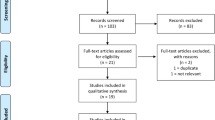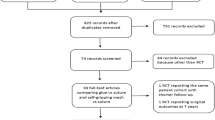Abstract
Self-gripping mesh is widely used in laparoscopic inguinal hernia repair and some researches report its advantages compared with conventional mesh. The aim of this study was to assess outcomes of self-gripping mesh and conventional mesh in laparoscopic inguinal hernia repair. A systematic literature review was undertaken to identify studies comparing the results of self-gripping mesh and conventional mesh in laparoscopic inguinal hernia repair. Outcomes, including recurrence, chronic pain, operation time, hematoma, seroma and infection, were measured. Four randomized controlled trials and 1 prospective comparative study were analyzed. The incidence of chronic pain in self-gripping group was significantly lower than that in conventional group (OR 0.43, 95% CI 0.20, 0.93, P = 0.03), and there was no significant difference in hernia recurrence (OR 0.31, 95% CI 0.03, 3.06, P = 0.32), operation time (MD 0.06, 95%CI − 2.32, 2.44, P = 0.96), hematoma (OR 1.01, 95% CI 0.33, 3.07, P = 0.99) and seroma (OR 0.90, 95% CI 0.49, 1.66, P = 0.73). Laparoscopic inguinal hernia repair using self-gripping mesh is associated with a decreased incidence of chronic pain compared with conventional mesh, without increased postoperative complications.






Similar content being viewed by others
References
Deans GT, Wilson MS, Royston CM et al (1995) Recurrent inguinal hernia after laparoscopic repair: possible cause and prevention. Br J Surg 82:539–541
Stark E, Oestreich K, Wendl K et al (1999) Nerve irritation after laparoscopic hernia repair. Surg Endosc 13:878–881
Antoniou SA, Köhler G, Antoniou GA et al (2016) Meta-analysis of randomized trials comparing nonpenetrating vs mechanical mesh fixation in laparoscopic inguinal hernia repair. Am J Surg 211:239–249
Molegraaf M, Kaufmann R, Lange J (2018) Comparison of self-gripping mesh and sutured mesh in open inguinal hernia repair: a meta-analysis of long-term results. Surgery 163:351–360
Hollinsky C, Kolbe T, Walter I et al (2009) Comparison of a new self-gripping mesh with other fixation methods for laparoscopic hernia repair in a rat model. J Am Coll Surg 208:1107–1114
Wang D, Zhang H, Lei T et al (2020) Randomized trial comparing self-gripping mesh with polypropylene mesh in female lichtenstein hernioplasty. Am Surg 86:110–115
Cambal M, Zonca P, Hrbaty B (2012) Comparison of self-gripping mesh with mesh fixation with fibrin-glue in laparoscopic hernia repair (TAPP). Bratisl Lek Listy 113:103–107
Romario UF, Puccetti F, Elmore U et al (2013) Self-gripping mesh versus staple fixation in laparoscopic inguinal hernia repair: a prospective comparison. Surg Endosc 27:1798–1802
Ferrarese A, Bindi M, Rivelli M et al (2016) Self-gripping mesh versus fibrin glue fixation in laparoscopic inguinal hernia repair: a randomized prospective clinical trial in young and elderly patients. Open Med 11:497–508
Law TT, Ng KK, Wei R et al (2020) A randomized controlled trial comparing short-term outcomes of self-gripping (Progrip) Mesh versus fibrin sealant in laparoscopic total extraperitoneal hernioplasty. Surg Laparosc Endosc Percutan Tech 30:203–208
Denham M, Johnson B, Leong M et al (2019) An analysis of results in a single-blinded, prospective randomized controlled trial comparing non-fixating versus self-fixating mesh for laparoscopic inguinal hernia repair. Surg Endosc 33:2670–2679
Schünemann H, Brożek J, Guyatt G, et al (2013) GRADE handbook for grading quality of evidence and strength of recommendations. The GRADE Working Group
Chinn S (2000) A simple method for converting an odds ratio to effect size for use in meta-analysis. Stat Med 19:3127–3131
Higgins JP, Thompson SG (2002) Quantifying heterogeneity in a meta-analysis. Stat Med 21:1539–1558
Shi Z, Fan X, Zhai S et al (2017) Fibrin glue versus staple for mesh fixation in laparoscopic transabdominal preperitoneal repair of inguinal hernia: a meta-analysis and systematic review. Surg Endosc 31:527–537
Sajid MS, Kalra L, Parampalli U et al (2013) A systematic review and meta-analysis evaluating the effectiveness of lightweight mesh against heavyweight mesh in influencing the incidence of chronic groin pain following laparoscopic inguinal hernia repair. Am J Surg 205:726–736
de Goede B, Klitsie PJ, van Kempen BJ et al (2013) Meta-analysis of glue versus sutured mesh fixation for Lichtenstein inguinal hernia repair. Br J Surg 100:735–742
Haroutiunian S, Nikolajsen L, Finnerup NB et al (2013) The neuropathic component in persistent postsurgical pain: a systematic literature review. Pain 154:95–102
Alfieri S, Amid PK, Campanelli G et al (2011) International guidelines for prevention and management of post-operative chronic pain following inguinal hernia surgery. Hernia 15:239–249
Li J, Ji Z, Li Y (2014) The comparison of self-gripping mesh and sutured mesh in open inguinal hernia repair: the results of meta-analysis. Ann Surg 259:1080–1085
Chastan P (2009) Tension-free open hernia repair using an innovative self-gripping semi-resorbable mesh. Hernia 13:137–142
Kolbe T, Hollinsky C, Walter I et al (2010) Influence of a new self-gripping hernia mesh on male fertility in a rat model. Surg Endosc 24:455–461
Stremitzer S, Bachleitner-Hofmann T, Gradl B et al (2010) Mesh graft infection following abdominal hernia repair: risk factor evaluation and strategies of mesh graft preservation. A retrospective analysis of 476 operations. World J Surg 34:1702–1709
Acknowledgements
The study was funded by Key Scientific Research Projects of Colleges and Universities in Henan Province in 2022 (Number: 22A320053).
Author information
Authors and Affiliations
Corresponding author
Ethics declarations
Conflict of interest
DCW, JWJ, YF and PQ declare no conflict of interest.
Research involving human participants and/or animals
This article does not contain any studies with human participants or animals performed by any of the authors.
Informed consent
For this type of study formal consent is not required.
Additional information
Publisher's Note
Springer Nature remains neutral with regard to jurisdictional claims in published maps and institutional affiliations.
Rights and permissions
About this article
Cite this article
Wang, D., Jiang, J., Fu, Y. et al. The comparison of self-gripping mesh and conventional mesh in laparoscopic inguinal hernia repair: the results of meta-analysis. Updates Surg 74, 857–863 (2022). https://doi.org/10.1007/s13304-021-01218-w
Received:
Accepted:
Published:
Issue Date:
DOI: https://doi.org/10.1007/s13304-021-01218-w




